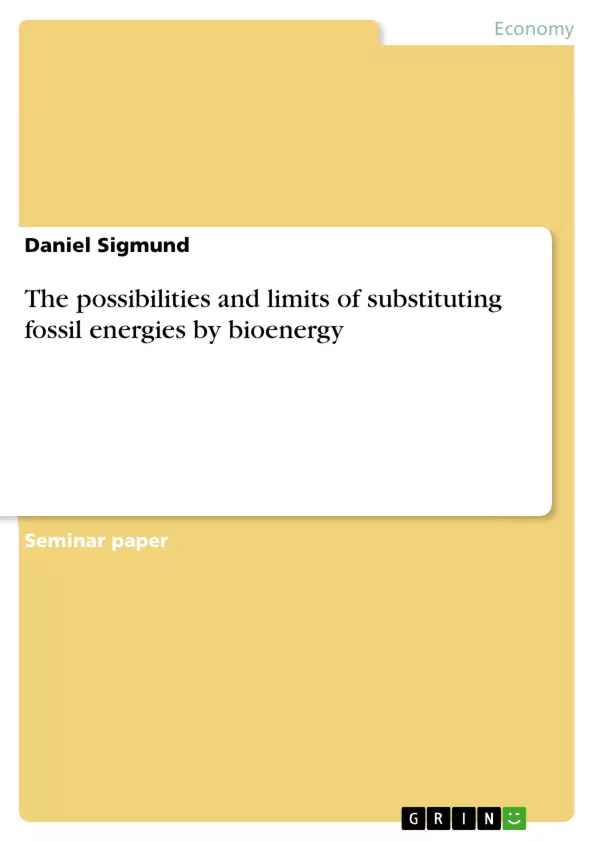This paper analyses how energy from biomass could be substituted for fossil energies. As a first step, we have to define different types of bioenergy and fossil energies. After this we will take a look at energetic assessments of concepts for the substitution of fossil energies and how complicated such evaluations can be.
Then we will analyse possibilities and limits of biogas as substitute for coal and natural gas used in the power generation and biofuels as substitute for diesel fuel and gasoline. Both of these applications are already in use so we can take a look at their benefits and drawback. We will analyse their environmental impact, their costs, and their potential to meet the actual and the future energy demand.
Renewable energies include energy by biomass. Could biomass be an alternative for fossil fuels? There are a lot of different ways how bioenergy can be produced and used. The use of energy from biomass is much older than from fossil fuels. It was not until the 20th century that fossil fuels in particular mineral oil started to dominate the world’s energy market.
The oldest and best-known example of using energy from biomass is the burning ofwood. Beside wood and other energy crops there is also the possibility of using biological residues to produce energy. This can be done by transforming the biomass into biogas to use it in power plants. But what about liquid fuels?
We cannot drive our cars with wood. It is possible to drive with biogas but almost the whole transport sector relies on liquid fuels. One idea is the substitution of fossil fuels with biofuels. For a few years biofuels has been used in Germany, but is the use of biofuels really better for our environment? And is it possible to substitute fossil fuels completely?
Inhaltsverzeichnis (Table of Contents)
- Introduction
- Theoretical background
- The sources of our energy
- What are fossil energies?
- What is bioenergy?
- Practical feasibility
- Biogas as substitute for natural gas and coal in the power generation...
- Biofuels as substitute for fossil fuels in the transport sector
- Conclusion
- References
Zielsetzung und Themenschwerpunkte (Objectives and Key Themes)
This paper examines the potential for substituting fossil fuels with bioenergy as a solution to the growing global energy demand. It discusses the limitations and possibilities of using biomass as an alternative energy source, considering its various forms and applications. The paper highlights the environmental impact, cost-effectiveness, and potential of bioenergy to fulfill current and future energy needs.
- The rising global energy demand and the depletion of fossil fuels
- The environmental impact of fossil fuels and the need for alternative energy sources
- The different types of bioenergy and their potential applications
- The economic and technical feasibility of substituting fossil fuels with bioenergy
- The environmental impact, cost-effectiveness, and potential of bioenergy
Zusammenfassung der Kapitel (Chapter Summaries)
- Introduction: The introduction highlights the increasing global energy demand and the depletion of fossil fuels. It introduces the concept of bioenergy as a potential alternative to fossil fuels, emphasizing its importance in addressing the growing energy needs while mitigating environmental concerns.
- Theoretical background: This chapter defines and classifies fossil energies and bioenergy, exploring their characteristics and potential advantages and disadvantages. It analyzes the sources of our energy, specifically highlighting the dominance of fossil fuels and the potential of bioenergy. The chapter examines the various forms of fossil energies, including mineral oil, natural gas, and coal, and discusses their limitations, including their environmental impact and dependence on foreign sources. It then delves into the concept of bioenergy, defining it as energy derived from biomass and highlighting its renewable nature. The chapter explores the diverse forms of biomass, its conversion routes, and the potential applications of bioenergy.
Schlüsselwörter (Keywords)
This paper examines the key themes of bioenergy, fossil fuels, energy demand, renewable energy sources, environmental impact, cost-effectiveness, and practical feasibility. The paper explores the potential of biomass as a substitute for fossil fuels in various applications, focusing on the benefits and challenges associated with different bioenergy conversion technologies. The paper also investigates the economic and environmental considerations of transitioning from fossil fuels to bioenergy.
- Quote paper
- Daniel Sigmund (Author), 2014, The possibilities and limits of substituting fossil energies by bioenergy, Munich, GRIN Verlag, https://www.grin.com/document/321275



